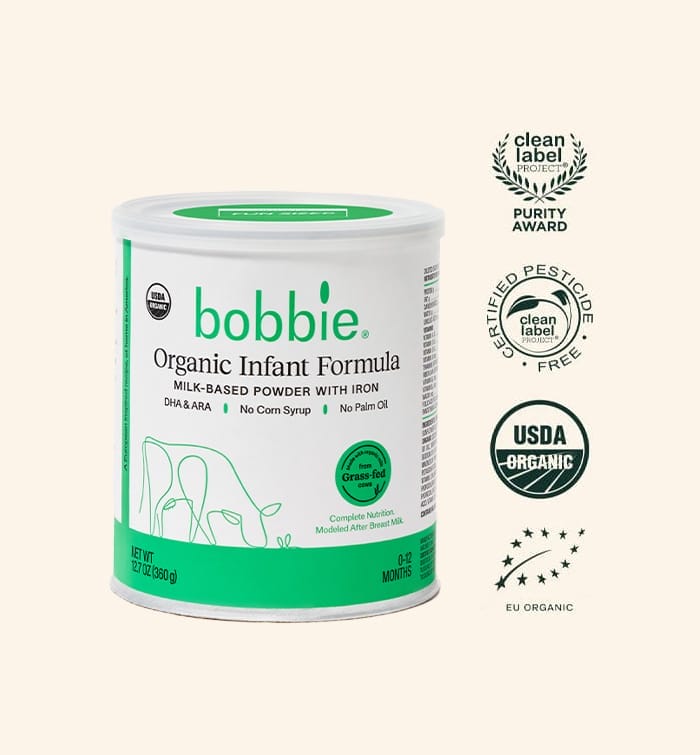We are proud to say that these posts are not sponsored. Our editorial team of Bobbie moms and writers personally select each featured product. If you buy something through our links, we may earn an affiliate commission, at no cost to you.
It seems like just when you’ve gotten the hang of feeding your infant and have a good routine, it’s time to start thinking about the next step in their feeding journey.
So when exactly are babies supposed to transition off of baby formula? And how do you do this? What about switching from breast milk? And how long can babies drink from a bottle anyway?
We’ve got answers to all your transition feeding questions so you can confidently switch from bottle to cup and formula or switch from breast milk to milk.
When to transition from formula to milk
Transitioning from formula to milk is a big step for you and your baby! There’s no exact age at which babies should switch, but the weaning process should begin soon after your baby is one year old.
By this time, they’re getting some nutrition from food, drinking some water, and are less dependent on formula for all their nutrition needs.

Shop Bobbie Organic Infant Formula
Bobbie Organic Infant Formula is a USDA Organic, EU-style infant formula that meets all FDA requirements. It is a complete nutrition milk-based powder modeled after breast milk and is easy on tummies. It is non-GMO and doesn't have corn syrup, palm oil, or maltodextrin. Learn more about Bobbie.
What age do you transition off of baby formula?
Transitioning off of your baby’s formula can feel scary. You want to ensure they’re getting all the nutrition they need without formula. Until your baby’s first birthday, they should only have formula, breast milk, or water (after 6 months) to drink.1 After their first birthday, you can begin to transition from formula to milk.
How long should babies have only breast milk or formula?
For the first 4 to 6 months of life, breast milk or formula is all your baby needs to grow and develop. During this time, infants will nurse or take a bottle frequently. Breastfed infants nurse about 8 to 12 times daily, and formula-fed infants take about 6 to 8 bottles daily.2
At 6 months, you can start offering your baby 4-8 ounces of water a day in addition to their formula or breastmilk.3 You may also begin offering solid foods at this time as well.
Signs your baby may be ready to try solid foods
According to the Centers for Disease Control (CDC), your baby may be ready to try solid foods if: 4
- They can sit independently with good head control.
- They show you they’re interested in food by opening their mouth and leaning forward when offered food.
- They swallow food rather than pushing it back out when offered.
- They try to hold small objects and bring them to their mouth.
There’s no need to introduce solid foods to your baby before they show signs of readiness. Doing so could increase the risk of choking if they’re not ready or able to swallow solids.
You can try new foods with your baby in any order but stick to foods with one ingredient (like a single pureed fruit or vegetable). Leave 3 to 5 days between trying new foods so you can tell if your baby has any intolerances or allergic reactions.4
How to transition from formula to milk
After 12 months, your baby has gotten used to the taste of formula and may not be as excited as you are about transitioning to milk. Making the switch doesn’t have to be stressful for you or your baby. Follow these strategies to wean your baby off formula in a gradual and enjoyable way. The switch from formula and bottles to milk and cups will happen in no time!
Transition your baby to whole cow’s milk
When transitioning your baby from formula to milk, it’s important to stick to whole cow’s milk, as the fat is important for brain development.5 One-year-olds need about 16 ounces of whole cow’s milk per day.6
Children should keep drinking whole cow’s milk until they are 2 years of age (unless your baby’s healthcare provider suggests a different option) and wait until after their second birthday to switch to lower fat milk.5
Transition gradually
The issue of how to transition can be a little trickier. Some babies can transition with no issues— a sippy cup of formula one day is replaced by a sippy cup of whole cow’s milk the next day- done!
Other babies struggle with the cold turkey approach and need a slower transition to whole cow’s milk to adjust to the new taste. Here are ways you can help them adjust to the change:7
- Start by putting some whole cow’s milk in their cereal or other pureed foods.
- Mix a small amount of whole cow’s milk into their cup or bottle of formula. Slowly increase the portion of whole cow’s milk and decrease the formula portion as they adjust.
- Serve cow’s milk warm if your baby is used to warm formula (but just like formula, never use a microwave to warm milk).
Remember, after your baby turns 1 year old, whole cow’s milk is just a drink for them and not a whole meal like formula or breast milk had been. They should be eating a variety of foods by this time.4
Introduce a sippy cup
Although babies usually won’t stop using bottles completely until they are between 12 and 18 months old, it’s a good idea to start introducing cups when they are about 6 months old— just around the time they start solid foods.1
Giving a 6 month old an open cup sounds like a recipe for disaster (and it usually is a little messy), but it’s important to let them experiment and learn around this time.
Drinking out of a bottle can increase the risk of tooth decay in infants and toddlers, so switching to a cup as soon as infants are developmentally ready helps keep their teeth healthy.1 Bottles also allow babies to drink more milk than a cup, which could lead to them drinking more than they need as they get older.7
Here are some steps to help your baby transition from a bottle to a sippy cup:1
- Let your baby hold a cup without any liquid in it.
- Add small amounts of water to the cup. Help them drink from it, then let them experiment with it on their own.
- At 8-10 months, introduce a sippy cup and replace one bottle daily with the sippy cup filled with formula.
- Each week, replace one more bottle with the sippy cup until your baby is no longer drinking out of their bottle.
Weaning off breastfeeding
Unlike formula, there is no set time to wean your baby from breastfeeding, and the decision to continue breastfeeding or make the switch to milk after 12 months is based on what feels and works best for you and your baby.8
If you have only ever breastfed, weaning for you may mean switching to pumped breast milk, formula, or whole cow’s milk, depending on your baby’s age and what works best for you both. If your baby is 6 months old or younger, you should transition to a bottle using formula or pumped breast milk. If your baby is older than 6 months, you can transition to a bottle or cup, as discussed above, using formula or pumped breast milk. Solid foods can be introduced as discussed above.7
Babies who wean off breast milk after 12 months of age can transition to whole cow’s milk just like a baby who takes formula. In this case, you can mix breast milk with whole cow’s milk to make the transition easier if needed.
The important facts when transitioning off of formula or breast milk
Many transitions take place with your baby’s eating and drinking during the first year of life. For the first 4 to 6 months they should only have breast milk or infant formula and nothing else.
Once they show signs of being ready to try solid foods, you can slowly begin introducing them. This is also a great time to start introducing a cup. Once your baby turns 1 year old, they should transition off formula to whole cow’s milk and work on getting off the bottle entirely.
If your baby is breastfed, you can continue breastfeeding as long as you both like while introducing solid foods around 6 months old and formula or whole cow’s milk (depending on your baby’s age) once you are ready to stop breastfeeding.
Remember to talk with your baby’s healthcare provider about their current feeding habits and your future feeding plans at every visit so that you can stay on track and get all of the personalized advice you need along the way.
Verified by: Kelsey Lorencz, RDN

Shop Bobbie Organic Infant Formula
Bobbie Organic Infant Formula is a USDA Organic, EU-style infant formula that meets all FDA requirements. It is a complete nutrition milk-based powder modeled after breast milk and is easy on tummies. It is non-GMO and doesn't have corn syrup, palm oil, or maltodextrin. Learn more about Bobbie.
Sources:
- Baby Bottle Weaning | UCSF Benioff Children’s Hospital
- What is Weaning and How Do I Do it? | National Institutes of Health
- Recommended Drinks for Children Age 5 and Younger | American Academy of Pediatrics
- When, What, and How to Introduce Solid Foods | CDC
- Making the Switch to Cow’s Milk for 1-year-olds | Children’s Hospital of Philadelphia
- How Do I Transition From Formula to Milk | California Women, Infants, and Children
- Stopping the Bottle | Nemours Children’s Health
- Weaning Your Child | Nemours Children’s Health

